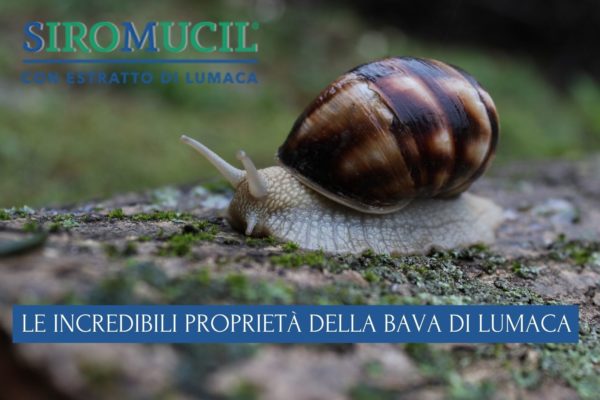Bibliografia
[1] Bonnemain B., Helix and Drugs: Snails for Western Health Care From Antiquity to the Present. eCAM 2005; 2(1)25–28.
[2] Koene J. M., Chase R., Changes in the reproductive system of the snail Helix aspersa caused by mucus from the love dart. The Journal of Experimental Biology 1998 Mar; 201:2313-2319.
[3] A.P. Williams, The chemical composition of Snail Gelatin, Bioch. 1960:74.
[4] Pawlicki J. M., Pease L.B., Pierce C.M., Startz T.P., Zhang Y., Smith A.M., The effect of molluscan glue proteins on gel mechanics. J Exp Biol. 2004 Mar; 207(Pt 7):1127-35.
[5] Gónzalez M., Egaña G., Muñoz N., Correa C., Snail Extract Cream in burn scars and grafts, COANIQUEM, August 2000, Environ Toxicol Chem. 2006 Mar; 25(3):815-22.
[6] Sverdrup L.E., De Vaufleury A., Hartnik T., Hagen S.B., Loibner A.P., Jensen J., Effects and uptake of polycyclic aromatic compounds in snails (Helix aspersa). Environ Toxicol Chem. 2006 Jul; 25(7):1941-5.
[7] Menta C., Parisi V., Metal concentrations in Helix pomatia, Helix aspersa and Arion rufus: a comparative study.
Environmental Pollution 115 (2001) 205–208.
[8] Ramos-Vasconcelos G.R., Cardoso L.A., Hermes-Lima M., Seasonal modulation of free radical metabolism in estivating land snails Helix aspersa. Comp Biochem Physiol C Toxicol Pharmacol. 2005 Feb; 140(2):165-74.
[9] Nowakowska A., Caputa M., Rogalska J., Defence against oxidative stress in two species of land snails (Helix pomatia and Helix aspersa) subjected to estivation. Journal of Experimental Zoology, 2011; 315:593-601.
[10] Ansart A., Vernon P., Daguzan J., Effects of a freezing event during hibernation on further survival, reproduction and growth in the partially freezing tolerant land snail Helix aspersa muller (Gasteropoda: helicidae). Cryo Letters. 2002 Jul-Aug; 23(4):269-74.
[11] Arata J., Hatakemaka K., Oono T., Effect of topical application of glycine and proline on recalcitrating ulcers of prolidase deficiency. Arch.Dermatol. 1986 Jun; 122(6):626-7.
[12] Garcia M.P., Escolano M.A., Segura P., Melgares M.L., Effective theraly with a glicine-proline ointment in a patient with recurrent ulcers from prolidase deficiency. Farm. Hosp. 2006 Set-Oct; 30(5): 304-8.
[13] Raucher S., Baud S., Miao M., Keeley F.W., Pomès R., Proline and glycine control protein self-organisation into elastomeric or amyloid fibrils. Structure 2006 Nov, 14(11):1667-76.
[14] Kim S.J., Park J.H., Kim D.H., Won Y.H., Maibach H.I., Increased in vivo collagen synthesis and in vitro cell proliferative effect of glycolic acid. Dermatol Surg. 1998 Oct; 24(19):1054-8.
[15] Inan S., Oztukcan S., Vatansever S., Ermertcan A.T., Zeybek D., Oksal A., Giray G., Muftuoglu S., Histopathological and ultrastructural effects of glyclic acid on rat skin. Acta Histochem 2006; 108(1):37-47.
[16] Bernstein E.F., Lee J., Brown D.B., Yu R., Van Scott E., Glycolic acid treatment increases type I collagen mRNA and Hyaluronic acid content of human skin. Dermatol. Surg. 2001 May; 27(5):429-33.
[17] Sito G., Sorrentino L., Interaction between bovine collagen and glycolic acid peeling: a proposal of a new protocol. Aestetic Plast. Surg. 1996 Jul-Aug; 20(4):337-41.
[18] Zhong J., Wenhong W, Yang X., Yan X., Liu R., A novel cysteine-rich antimicrobial peptide from the mucus of the snail of Achatina fulica. Peptides 39 (2013):1–5.
[19] Zanotti Russo M., Trattare i danni cutanei naturalmente, http://www.lapelle.it/ricerca/bava_di_lumaca.htm, april 2012.
[20] Avagnina G., Elicicoltura, Ed. Istituto Internazionale Elicicoltura di Cherasco, Sept. 2011; 162-168



